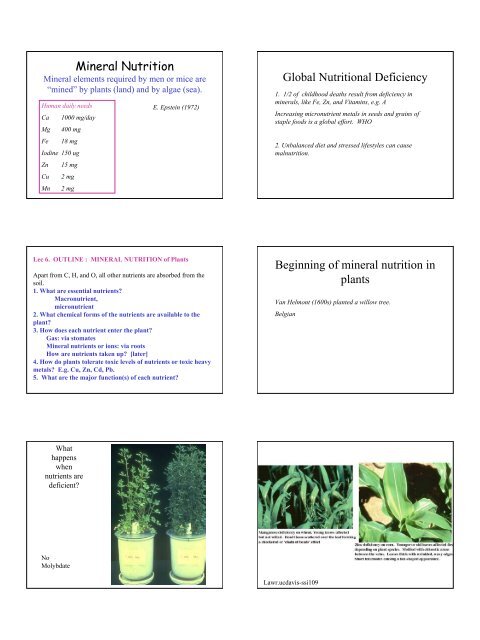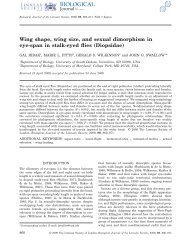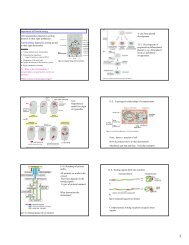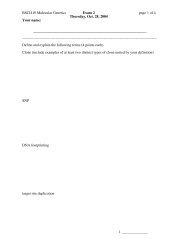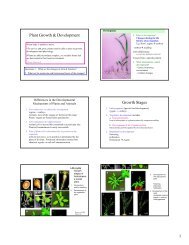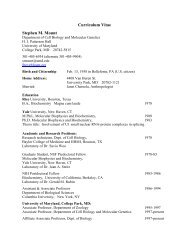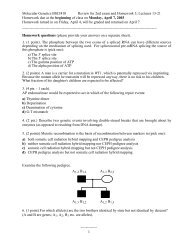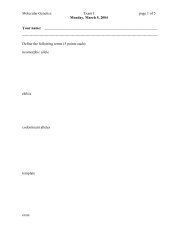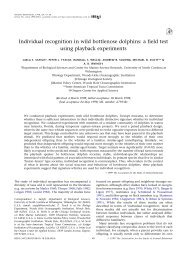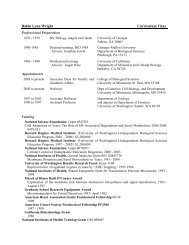Mineral Nutrition Global Nutritional Deficiency Beginning of mineral ...
Mineral Nutrition Global Nutritional Deficiency Beginning of mineral ...
Mineral Nutrition Global Nutritional Deficiency Beginning of mineral ...
- No tags were found...
Create successful ePaper yourself
Turn your PDF publications into a flip-book with our unique Google optimized e-Paper software.
<strong>Mineral</strong> <strong>Nutrition</strong><strong>Mineral</strong> elements required by men or mice are“mined” by plants (land) and by algae (sea).Human daily needsCa 1000 mg/dayMg 400 mgFe 18 mgIodine 150 ugZn 15 mgCu 2 mgMn 2 mgE. Epstein (1972)<strong>Global</strong> <strong>Nutrition</strong>al <strong>Deficiency</strong>1. 1/2 <strong>of</strong> childhood deaths result from deficiency in<strong>mineral</strong>s, like Fe, Zn, and Vitamins, e.g. AIncreasing micronutrient metals in seeds and grains <strong>of</strong>staple foods is a global effort. WHO2. Unbalanced diet and stressed lifestyles can causemalnutrition.Lec 6. OUTLINE : MINERAL NUTRITION <strong>of</strong> PlantsApart from C, H, and O, all other nutrients are absorbed from thesoil.1. What are essential nutrients?Macronutrient,micronutrient2. What chemical forms <strong>of</strong> the nutrients are available to theplant?3. How does each nutrient enter the plant?Gas: via stomates<strong>Mineral</strong> nutrients or ions: via rootsHow are nutrients taken up? [later]4. How do plants tolerate toxic levels <strong>of</strong> nutrients or toxic heavymetals? E.g. Cu, Zn, Cd, Pb.5. What are the major function(s) <strong>of</strong> each nutrient?<strong>Beginning</strong> <strong>of</strong> <strong>mineral</strong> nutrition inplantsVan Helmont (1600s) planted a willow tree.BelgianWhathappenswhennutrients aredeficient?NoMolybdateLawr.ucdavis-ssi109
N deficiencyin cornLawr.ucdavis-ssc109Fe deficiencyhttp://www.back-tobasics.net/nds/index.htm#Mg deficiencyin cornEssential nutrients are those nutrients which arenecessary for a plant to complete its life cycle, and for which noother element can substitute.Essential nutrient must have a clear function.A. Nutrient & Conc. requiredMacronutrients (elements):C, H, O, N, K, Ca, Mg, P, SMicronutrient:Cl, Fe, B, Mn, Zn, Cu, Mo, Ni> 1 mM< 1 mM (µM)K <strong>Deficiency</strong>Boron deficiency in almondwww.nrs.mcgill.ca/.../ Boron/BigPixB.htmlB. Biochemical Functions1) carbohydrates, lipids, Proteins, nucleic acidsCHO CHO CHON(S) CHONP2) Coenzyme: Mg, Ca, Mn, Zn,Fe, Cu, Mo, Mn [redox rx]3) Osmotic and electrical components: K + ,Cl - , H + , Ca 2+4) B cross-links sugars in cell wall pectin
Boron cross-links pectin RGIITable 5.1 Taiz. Essential nutrients required by plantsA. Macronutrient Available Conc in Dry matterForm umol/g µM [medium]H H 2 O 60,000C CO 2 40,000O O 2 , CO 2 30,000N NO 3- , NH+4 1,000 16,000K K + 250 6,000Ca Ca + + 125 4,000Mg Mg + + 80 1,000P H 2 PO 4- , HPO--4 60 2,000S SO--4 30 1,0005-3. Nutrient level is important for optimal growthB. Micronutrient Available Form umol/g µMNa Na +Cl Cl - 3.0 50B BO-3 2 25Mn Mn 2+ 1 2Zn Zn 2+ 0.3 2Cu Cu 2+ 0.1 0.5Mo MoO4 - 0.001 0.5Fe Fe 2+ 1.0-3.0 16-50OptionalNi Ni 2+ 0.02 0.5Si Si 28 1,0005-4. Soil pHaffects Nutrientavailability5-6. Wheat Root A. Dry soil B. Irrigated soil
Pi levelinfluenceLateral rootdevelopment-Lupinus5-8. Apex <strong>of</strong> root+ 1 mM Pi-Pi0 mMRecap1. Plants require essential nutrients at varying levels.2. <strong>Deficiency</strong> in nutrients reduce productivity3. Too much can cause toxicity.Plants are able to adapt to soils with different levels <strong>of</strong>nutrients and can transport ions selectively.Questions?How do plants regulate how much it takes up?How do they get rid <strong>of</strong> excess nutrients?Transport <strong>of</strong> ions andmetabolites:1. How do plants take up,distribute, & sort nutrients inorgans and in cells?2. How do plants deal with excessions and toxic metals?3. What controls guard cellmovement?Changes in ion levels and watermovement4. Form <strong>of</strong> communicationTRANSPORTHow are essential <strong>mineral</strong> nutrients taken up and distributed inthe plant?Concepts1. p-lipid bilayer is a remarkable barrier2. Proteins catalyze transport <strong>of</strong> nutrients and metabolites just asenzymes catalyze chemical reactions. There are 3 main classes <strong>of</strong>transport proteins.Channels,PumpsCarriers3. Transport can be active or passive.Passive and active transport <strong>of</strong> ions result in electric potentialdifference across membranes4. Major Transport Proteins in Plantsa. H+ pumping ATPases are the major ion pumps in plantsb. Active transport <strong>of</strong> many nutrients and metabolites depend on H+coupledco-transport. Energy from H+ gradient is used to driveuphill movement <strong>of</strong> other nutrients.c. Channels allow rapid, passive transport <strong>of</strong> ions and metabolites.d. Water is transported via WATER CHANNELS orAQUAPORINS in membranes that conduct large volumes <strong>of</strong> waterrapidly.
Taiz. P-lipid is a remarkable barrier to ions6-7. Proteins catalyze transport.Channel, carrier pumpActiveFig. 2-17 Taiz. Protein catalyze transport just like enzymescatalyze chemical reactions. Specific, fast3. Transport can be active or passive.•Passive transport is movement down an electrochemical gradient.•Active transport is movement against an electrochemical gradient.What is an electrochemical gradient?∆µ = conc gradient + electrical gradientChemical gradientElectrical gradient: unequal distribution <strong>of</strong> charges across a membrane.Passive or active transport <strong>of</strong> ions result in electric potentialdifference across membranes.••How do you know if an ion is moving uphill or downhill?Nernst equation•It predicts passive ion distribution for a given electrical potential.Diffusion <strong>of</strong> uncharged species depend only on theconcentration gradient.6-2. Taiz. A diffusion potential develops when + & - ions diffuseacross a membrane at different rates.Diffusion <strong>of</strong> charged species is dependent on theconcentration and the electrical gradient.MoreK+
Pump potential is generated when there is an active ion pump.F 6-3 Taiz. Microelectrodes are used to measure membranepotentials across cell membranePumppotentialATPProton transportis a majordeterminant <strong>of</strong> themembranepotential.H + K+DiffusionpotentialWhat is the driving force for uphill movement?ATP and a H + electrochemical gradient6-5. Evidence for a Pump potential and diffusion potential.Nernst equation states that at equilibrium the difference inconcentration <strong>of</strong> an ion between two compartments isbalanced by the voltage difference. Thus it can predict the ionconc at equilibrium at a certain ∆E.Very useful to predict active or passive transport <strong>of</strong> an ion.


